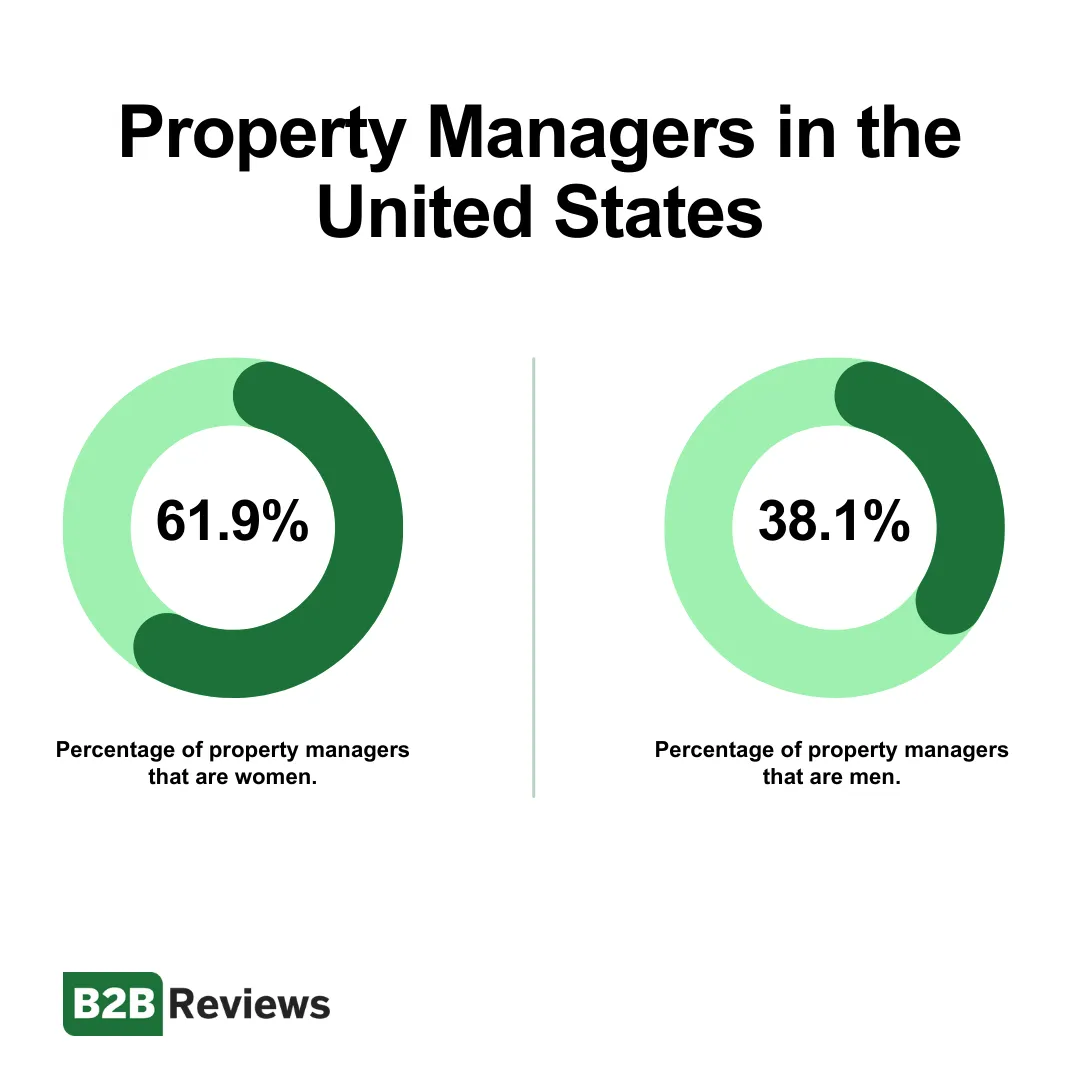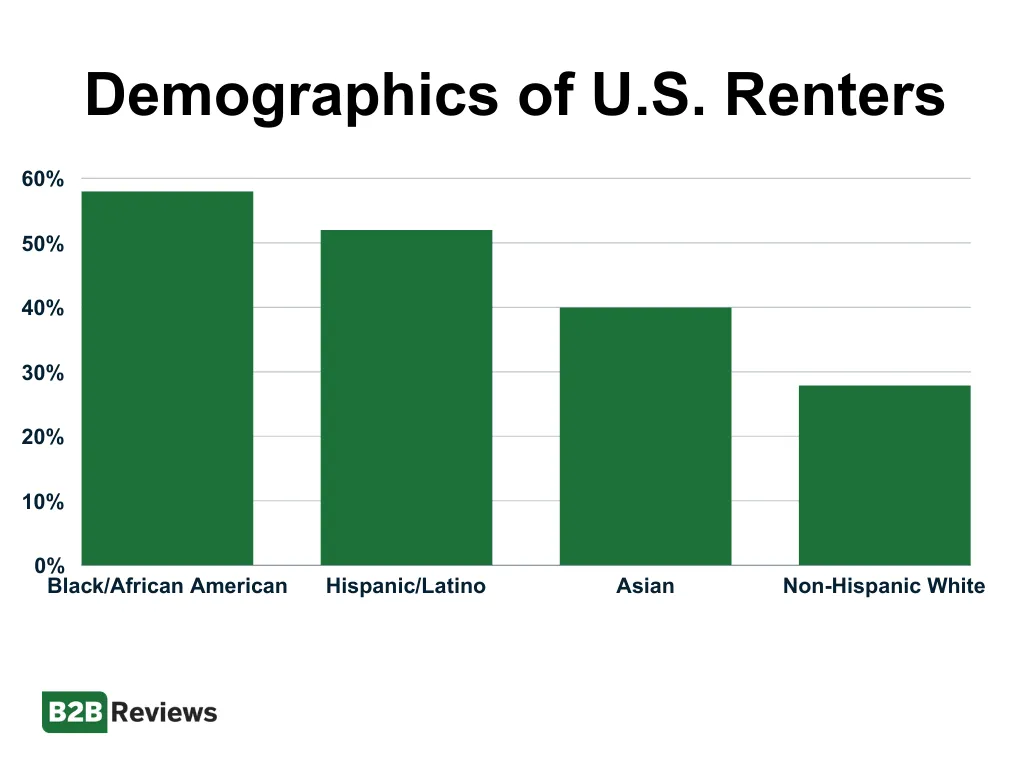We may earn money when you click on links to our partners. Advertiser Disclosure
Property management companies provide services that streamline operations, enhance tenant experiences, and simplify tasks like maintenance, rent collection, and leasing. And with the increasing demand for rental properties and quality tools, the property management industry is expected to grow.
B2B Reviews took a closer look at this growing industry to gain insights into its current state, technology trends, and future predictions.
Key Takeaways
- There are an estimated 326,000 property management companies in the U.S.
- There are 19,341,000 rental properties in 2024.
- Women make up 61.9% of U.S. property managers.
- 7-in-10 rental properties are owned by individuals rather than businesses.
- There are an estimated 124,866 property managers in the United States.
Property Management Companies in the U.S.
Over the past few years, the number of property management companies has increased, especially in the United States.
- In 2024, the U.S. has an estimated 326,000 property management companies.
- This number has increased since 2023, when there were about 296,477 property management companies.
- Between 2018 and 2023, the property management industry grew, on average, 2.1% per year.
The Census Bureau’s most recent Rental Housing Finance Survey (RHFS) shares insights into the number of rental properties and units within the United States:
- There are 19,341,000 rental properties in the United States.
- There are approximately 49,547,000 individual units.
With nearly 20 million rental properties to manage, it is no surprise the industry is continuing to grow and gain worth.
- As of 2024, the industry size of property management software is estimated at 25.1 billion dollars.
- In annual revenue, the property management industry generates around $99.5 billion.
While the industry is growing nationwide, some states have more active property management software installations than others. Below is a list of the states with the most active installations (or units), according to Strategic Market Research:
- California—19,248 units
- Texas—14,436 units
- Florida—12,030 units
- New York—10,827 units
- Pennsylvania—6,015 units
There are over 140 million housing units in the United States, and this number will likely continue to rise. The property management industry will continue to grow to meet the needs of managers nationwide.
Property Manager Statistics
To properly understand the property management market, we must look at the managers who use the industry’s services. Especially considering that 51% of rental property owners have a property manager.
According to Strategic Market Research, there are 124,866 property managers in the United States.
- Women make up 61.9% of U.S. property managers.
- Men make up 38.1% of property managers in the U.S.

Strategic Market Research also determined the states with the most property managers. Below are the top states with the most number of property managers:
- California—37,600.
- Texas—28,200
- Florida—23,500
- New York—21,150
These properties are owned and managed by individuals and for-profit businesses; however, most are owned by individuals.
- About 7-in-10 rental properties are owned by individuals.
- These individuals usually own one or two properties.
- Less than one-fifth of rental properties are owned by for-profit businesses.
While businesses own fewer rental properties, they own larger shares of units because their properties tend to be larger. According to the Pew Research Center:
- 69.5% of properties with 25+ units are owned by for-profit businesses.
- 72.5% of single-unit properties are owned by individuals.
Another source confirms this information. Mom-and-pop landlords (aka individual investor landlords) own about 41% of the approximately 50 million rental listings, which they manage daily. (This metric only focuses on rental properties, not all housing units.)
Interestingly, most of these landlords handle property repairs for their tenants, which is made easier with property management software.
- 89% of landlords handle property repairs.
- Only 11% leave property maintenance to the tenants.
Renting Statistics
Renters also affect the property management industry. Below are some statistics that give insights into the renters in the U.S.
- More than 50% of renters used the internet to find their homes.
- 2021 saw a 20% increase in rental applications from high-earning Millennials.
- Applications from Gen X buyers rose by 12%.
- Baby Boomer’s applications grew by 7%, indicating a shift towards younger renters.
Unsurprisingly, those under 35 are more likely to rent than any other generation.
- 65.9% of people under 35 live in rentals.
- 42% of people 35 to 44 rent their places.
- 31.5% of people age 45 to 54 live in rentals.
Renting homes also differs between demographics nationwide.
- 58% of Black households rent.
- 52% of Hispanic or Latino households rent their homes.
- 40% of Asian households rent.
- 27.9% of non-Hispanic white households live in rentals.

Since 2010, rental rates have drastically increased, and renters have felt this burden intensely.
- Average rent increased 31% from 2010 to 2022.
- Rent that would have been $1,000 a month in 2010 would cost $1,310 a month in 2022.
- This indicates an additional rent of $3,720 a year.
Unfortunately, with the unrelenting growth of inflation, rent will likely continue to rise.
Property Management Industry Predictions
The Property Management Software Market is expected to grow in the coming decade.
- In 2023, the market was worth over $23.04 billion.
- It’s anticipated to reach more than $64.42 billion by the end of 2036.
- The market is expected to have a more than 8.9% CAGR between 2024-2036.
By 2023, the North American Property Management Software industry is expected to hold the largest revenue share due to the rising demand for rental properties.
Another aspect of this expected growth is due to innovations like artificial intelligence (AI) and other smart software in the property management industry.
The use of SaaS in property management is also expected to grow, contributing to the overall worth of the industry.
- In 2020, only 35% of companies ran their organization on SaaS.
- It’s expected by 2025, over 80% of businesses will switch to using SaaS in property management.
The cloud segment is also expected to grow, gaining a 60% market share between 2024-2036. This is due to the real estate industry and other large enterprises shifting to cloud-based property management solutions.
The Bottom Line
The Property Management Industry has experienced steady growth over recent years. Nationwide, there are over 140 million housing units, and property management companies are vital in maintaining and streamlining operations. As the number of units increases, the property management industry is projected to grow, reaching a more than 8.9% CAGR by 2036.
With more than 326,000 property management companies in the United States, managers need to research to find the company that can best streamline their operations and meet their unique needs. B2B Reviews created a list of the best Property Management Software providers in 2025; take a look to find which one is best for you.
- IBISWorld, “Property Management in the US – Number of Businesses.” Accessed September 19, 2024.
- Pew Research Center, “As national eviction ban expires, a look at who rents and who owns in the U.S.” Accessed September 20, 2024.
- Rentme, “36 Property Management Statistics for Landlords & Tenants.” Accessed September 19, 2024.
- Research Nester, “Property Management Software Market: Global Market Size, Forecast, and Trend Highlights Over 2024-2036.” Accessed September 20, 2024.
- RubyHome, “Property Management Industry Statistics (2024).” Accessed September 19, 2024.
- Strategic Market Research, “Property Management Industry Statistics and Growth Trends 2023.” Accessed September 19, 2024.
- The United States Census Bureau, “Rental Housing Finance Survey (RHFS).” Accessed September 20, 2024.
